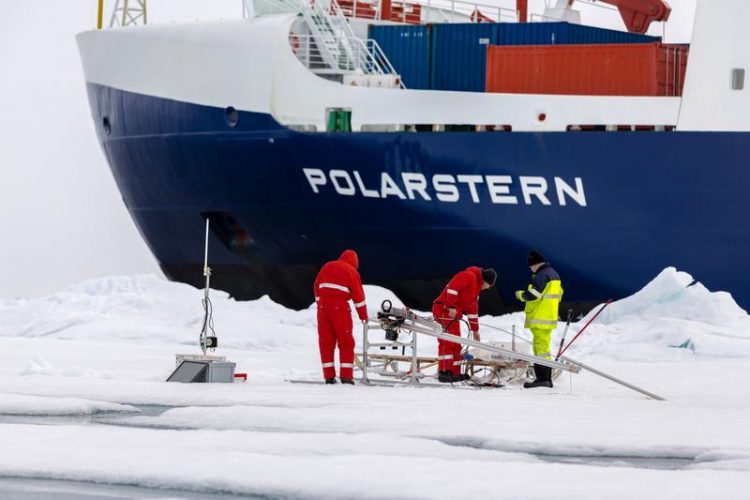Sea Ice Plays a Pivotal Role in the Arctic Methane Cycle

Installation of under-ice sensors during an ice station Photo: Alfred-Wegener-Institut / S. Hendricks
The ice-covered Arctic Ocean is a more important factor concerning the concentration of the greenhouse gas methane in the atmosphere than previously assumed. Experts from the Alfred Wegener Institute, Helmholtz Centre for Polar and Marine Research (AWI) report on the newly discovered interactions between the atmosphere, sea ice and the ocean in a recent online study in the journal Nature’s Scientific Reports.
Sea ice forms a natural barrier on the Central Arctic Ocean, limiting gas exchange between water and atmosphere. Over the past several years, the summer sea ice cover in the Arctic has rapidly decreased. “We’re investigating how the changed conditions are affecting the geochemical interaction between the ocean, ice and atmosphere,” explains Dr Ellen Damm, the first author of the study and a biogeochemist at the Alfred Wegener Institute.
“We were able to confirm that the surface water in the central Arctic contains higher methane concentrations than the atmosphere, which means the Arctic Ocean is a potential source of atmospheric methane. That makes it fundamentally different from oceans in lower latitudes, which – except for a few sporadic sources – are considered methane sinks.”
For the study, Damm and her colleagues from the AWI, the Finnish Meteorological Institute and the University of Bremen analysed geochemical and oceanographic data gathered during a 2011 expedition to the Arctic with the research icebreaker Polarstern. They measured methane levels in both the sea ice and in the water directly below it, and in deeper seawater entirely unaffected by the ice.
“Our study shows that there are previously overlooked feedbacks between ice melting and formation, the atmosphere, and the seawater influenced by ice,” says Damm.
Among other factors, they analysed the salt solution, i.e. the brine, which is constitutes concentrated seawater resulting during the formation of sea ice. They found that the brine had a thousand times higher concentration of methane than the atmosphere – proof that sea ice can be a source of methane.
As a result of the melting and freezing processes, methane in the brine channels can be released into the seawater. Further, the water remains in stable layers, due to the different densities of freshwater and saltwater. As such, the methane from the brine channels remains in the uppermost water layer throughout the summer.
When autumn storms set in and it gets colder, different water layers become mixed (convection), which can release the greenhouse gas into the atmosphere. At that time of year the sea ice cover is fragmented and the “lid” on the ocean has almost disappeared, conditions that are conducive to the release of methane into the atmosphere. The convection-based mixing continues in the winter, and methane continues to escape through the leads between ice floes.
The stable water layers prevent the methane from mixing to greater depths of the Arctic Ocean; the significantly lower methane concentrations (compared to the atmosphere) in the lower layer unaffected by the ice, verify this process. This has two effects: firstly, the newly discovered and as such not previously accounted for near-surface feedback mechanism can lead to the direct release of methane from the sea ice and ocean into the atmosphere.
Secondly, the exchange between atmosphere and the deeper Arctic Ocean is reduced, which also limits the Arctic Ocean’s capacity to act as a methane sink. Co-author and AWI oceanographer Prof Ursula Schauer summarises the study’s importance as follows: “The role of sea ice in gas exchange and gas flux is much more complex than previously assumed, and the processes at work in the Northern Ocean differ greatly from those in lower latitudes. These aspects have to be kept in mind in future climate models.”
Further, she points out, the study raises the question on where the methane originates. Conceivably, methane could be produced in sea ice as it drifts through the Arctic, or methane trapped in sea ice could be transported from other regions.
Original publication:
Ellen Damm, Bert Rudels, Ursula Schauer, Susan Mau and Gerhard Dieckmann: Methane excess in Arctic surface water-triggered by sea ice formation and melting. Nature online: Scientific Reports | 5:16179 | DOI: 10.1038/srep16179
Notes for Editors:
Please find printable images on http://www.awi.de/nc/en/about-us/service/press/press-release/meereis-spielt-eine-wichtige-rolle-im-arktischen-methankreislauf.html. Your contact persons are Dr Ellen Damm (tel. ++49 471 4831-1423; e-mail: Ellen.Damm(at)awi.de) and Dr Folke Mehrtens, Dept. of Communications and Media Relations (tel. ++49 471 4831-2007; e-mail: Folke.Mehrtens(at)awi.de).
The Alfred Wegener Institute conducts research in the Arctic, Antarctic and in the high and mid-latitude oceans. The Institute coordinates German polar research and provides important infrastructure such as the research icebreaker Polarstern and research stations in the Arctic and Antarctic to the national and international scientific world. The Alfred Wegener Institute is one of the 18 research centres of the Helmholtz Association, the largest scientific organisation in Germany.
Media Contact
More Information:
http://www.awi.deAll latest news from the category: Earth Sciences
Earth Sciences (also referred to as Geosciences), which deals with basic issues surrounding our planet, plays a vital role in the area of energy and raw materials supply.
Earth Sciences comprises subjects such as geology, geography, geological informatics, paleontology, mineralogy, petrography, crystallography, geophysics, geodesy, glaciology, cartography, photogrammetry, meteorology and seismology, early-warning systems, earthquake research and polar research.
Newest articles

First-of-its-kind study uses remote sensing to monitor plastic debris in rivers and lakes
Remote sensing creates a cost-effective solution to monitoring plastic pollution. A first-of-its-kind study from researchers at the University of Minnesota Twin Cities shows how remote sensing can help monitor and…

Laser-based artificial neuron mimics nerve cell functions at lightning speed
With a processing speed a billion times faster than nature, chip-based laser neuron could help advance AI tasks such as pattern recognition and sequence prediction. Researchers have developed a laser-based…

Optimising the processing of plastic waste
Just one look in the yellow bin reveals a colourful jumble of different types of plastic. However, the purer and more uniform plastic waste is, the easier it is to…



